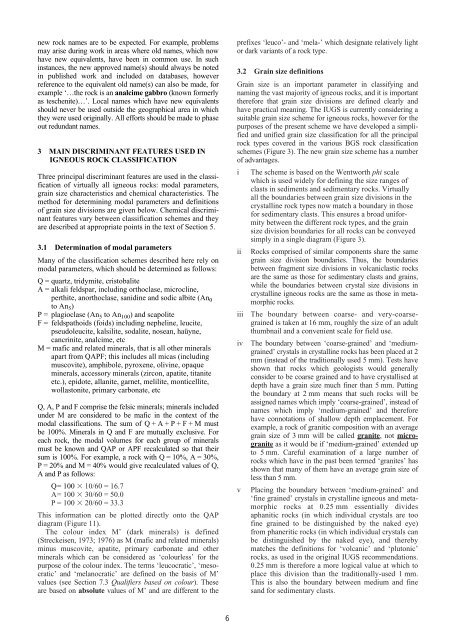Rock Classification Scheme (BGS).pdf - The Water, Sanitation and ...
Rock Classification Scheme (BGS).pdf - The Water, Sanitation and ...
Rock Classification Scheme (BGS).pdf - The Water, Sanitation and ...
You also want an ePaper? Increase the reach of your titles
YUMPU automatically turns print PDFs into web optimized ePapers that Google loves.
new rock names are to be expected. For example, problemsmay arise during work in areas where old names, which nowhave new equivalents, have been in common use. In suchinstances, the new approved name(s) should always be notedin published work <strong>and</strong> included on databases, howeverreference to the equivalent old name(s) can also be made, forexample ‘…the rock is an analcime gabbro (known formerlyas teschenite)…’. Local names which have new equivalentsshould never be used outside the geographical area in whichthey were used originally. All efforts should be made to phaseout redundant names.3 MAIN DISCRIMINANT FEATURES USED INIGNEOUS ROCK CLASSIFICATIONThree principal discriminant features are used in the classificationof virtually all igneous rocks: modal parameters,grain size characteristics <strong>and</strong> chemical characteristics. <strong>The</strong>method for determining modal parameters <strong>and</strong> definitionsof grain size divisions are given below. Chemical discriminantfeatures vary between classification schemes <strong>and</strong> theyare described at appropriate points in the text of Section 5.3.1 Determination of modal parametersMany of the classification schemes described here rely onmodal parameters, which should be determined as follows:Q = quartz, tridymite, cristobaliteA = alkali feldspar, including orthoclase, microcline,perthite, anorthoclase, sanidine <strong>and</strong> sodic albite (An 0to An 5 )P = plagioclase (An 5 to An 100 ) <strong>and</strong> scapoliteF = feldspathoids (foids) including nepheline, leucite,pseudoleucite, kalsilite, sodalite, nosean, haüyne,cancrinite, analcime, etcM = mafic <strong>and</strong> related minerals, that is all other mineralsapart from QAPF; this includes all micas (includingmuscovite), amphibole, pyroxene, olivine, opaqueminerals, accessory minerals (zircon, apatite, titaniteetc.), epidote, allanite, garnet, melilite, monticellite,wollastonite, primary carbonate, etcQ, A, P <strong>and</strong> F comprise the felsic minerals; minerals includedunder M are considered to be mafic in the context of themodal classifications. <strong>The</strong> sum of Q +A+P+F+M mustbe 100%. Minerals in Q <strong>and</strong> F are mutually exclusive. Foreach rock, the modal volumes for each group of mineralsmust be known <strong>and</strong> QAP or APF recalculated so that theirsum is 100%. For example, a rock with Q = 10%, A = 30%,P = 20% <strong>and</strong> M = 40% would give recalculated values of Q,A <strong>and</strong> P as follows:Q= 100 10/60 = 16.7A= 100 30/60 = 50.0P = 100 20/60 = 33.3This information can be plotted directly onto the QAPdiagram (Figure 11).<strong>The</strong> colour index M’ (dark minerals) is defined(Streckeisen, 1973; 1976) as M (mafic <strong>and</strong> related minerals)minus muscovite, apatite, primary carbonate <strong>and</strong> otherminerals which can be considered as ‘colourless’ for thepurpose of the colour index. <strong>The</strong> terms ‘leucocratic’, ‘mesocratic’<strong>and</strong> ‘melanocratic’ are defined on the basis of M’values (see Section 7.3 Qualifiers based on colour). <strong>The</strong>seare based on absolute values of M’ <strong>and</strong> are different to theprefixes ‘leuco’- <strong>and</strong> ‘mela-’ which designate relatively lightor dark variants of a rock type.3.2 Grain size definitionsGrain size is an important parameter in classifying <strong>and</strong>naming the vast majority of igneous rocks, <strong>and</strong> it is importanttherefore that grain size divisions are defined clearly <strong>and</strong>have practical meaning. <strong>The</strong> IUGS is currently considering asuitable grain size scheme for igneous rocks, however for thepurposes of the present scheme we have developed a simplified<strong>and</strong> unified grain size classification for all the principalrock types covered in the various <strong>BGS</strong> rock classificationschemes (Figure 3). <strong>The</strong> new grain size scheme has a numberof advantages.i <strong>The</strong> scheme is based on the Wentworth phi scalewhich is used widely for defining the size ranges ofclasts in sediments <strong>and</strong> sedimentary rocks. Virtuallyall the boundaries between grain size divisions in thecrystalline rock types now match a boundary in thosefor sedimentary clasts. This ensures a broad uniformitybetween the different rock types, <strong>and</strong> the grainsize division boundaries for all rocks can be conveyedsimply in a single diagram (Figure 3).ii <strong>Rock</strong>s comprised of similar components share the samegrain size division boundaries. Thus, the boundariesbetween fragment size divisions in volcaniclastic rocksare the same as those for sedimentary clasts <strong>and</strong> grains,while the boundaries between crystal size divisions incrystalline igneous rocks are the same as those in metamorphicrocks.iii <strong>The</strong> boundary between coarse- <strong>and</strong> very-coarsegrainedis taken at 16 mm, roughly the size of an adultthumbnail <strong>and</strong> a convenient scale for field use.iv <strong>The</strong> boundary between ‘coarse-grained’ <strong>and</strong> ‘mediumgrained’crystals in crystalline rocks has been placed at 2mm (instead of the traditionally used 5 mm). Tests haveshown that rocks which geologists would generallyconsider to be coarse grained <strong>and</strong> to have crystallised atdepth have a grain size much finer than 5 mm. Puttingthe boundary at 2 mm means that such rocks will beassigned names which imply ‘coarse-grained’, instead ofnames which imply ‘medium-grained’ <strong>and</strong> thereforehave connotations of shallow depth emplacement. Forexample, a rock of granitic composition with an averagegrain size of 3 mm will be called granite, not micrograniteas it would be if ‘medium-grained’ extended upto 5 mm. Careful examination of a large number ofrocks which have in the past been termed ‘granites’ hasshown that many of them have an average grain size ofless than 5 mm.v Placing the boundary between ‘medium-grained’ <strong>and</strong>‘fine grained’ crystals in crystalline igneous <strong>and</strong> metamorphicrocks at 0.25 mm essentially dividesaphanitic rocks (in which individual crystals are toofine grained to be distinguished by the naked eye)from phaneritic rocks (in which individual crystals canbe distinguished by the naked eye), <strong>and</strong> therebymatches the definitions for ‘volcanic’ <strong>and</strong> ‘plutonic’rocks, as used in the original IUGS recommendations.0.25 mm is therefore a more logical value at which toplace this division than the traditionally-used 1 mm.This is also the boundary between medium <strong>and</strong> fines<strong>and</strong> for sedimentary clasts.6
















